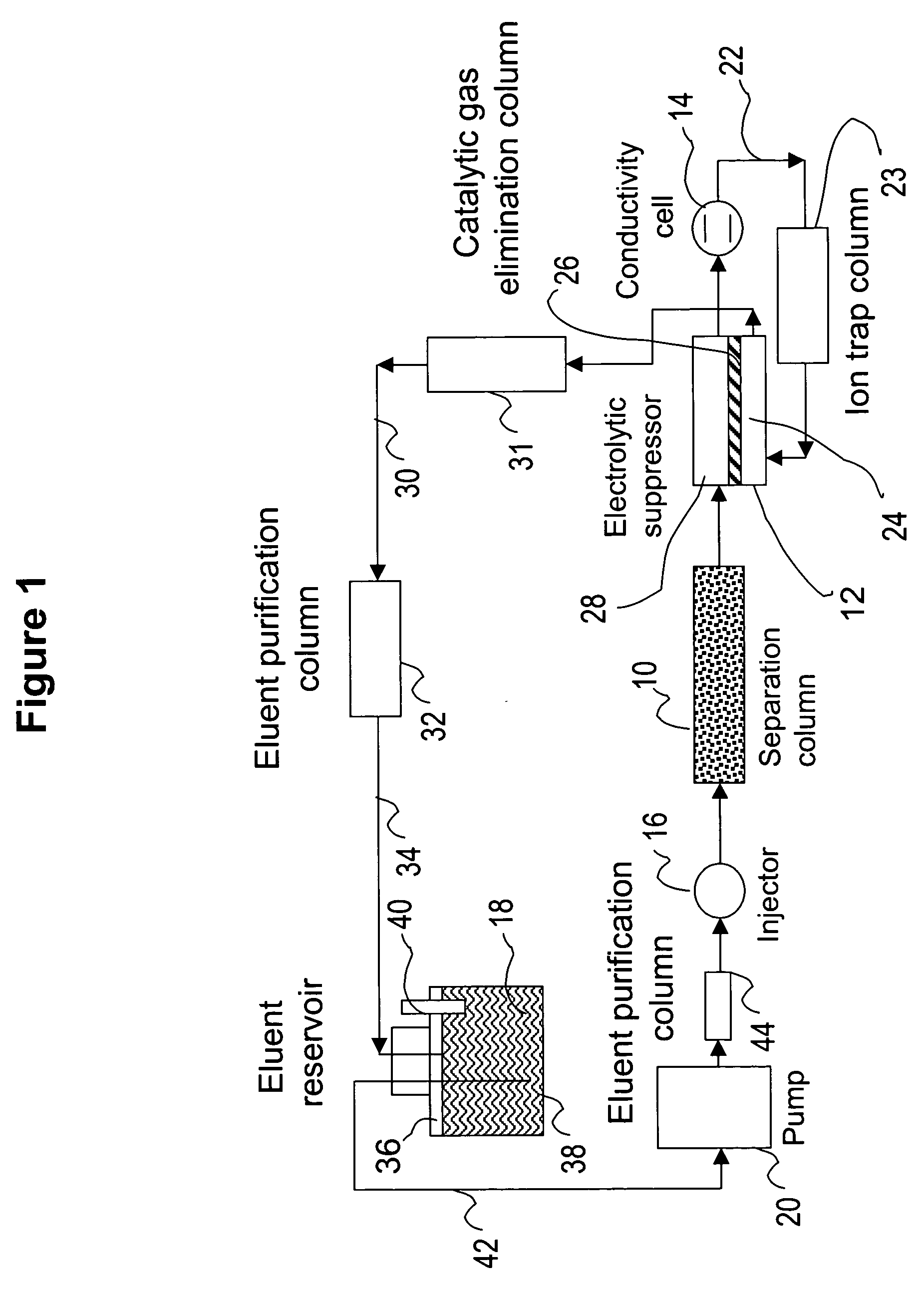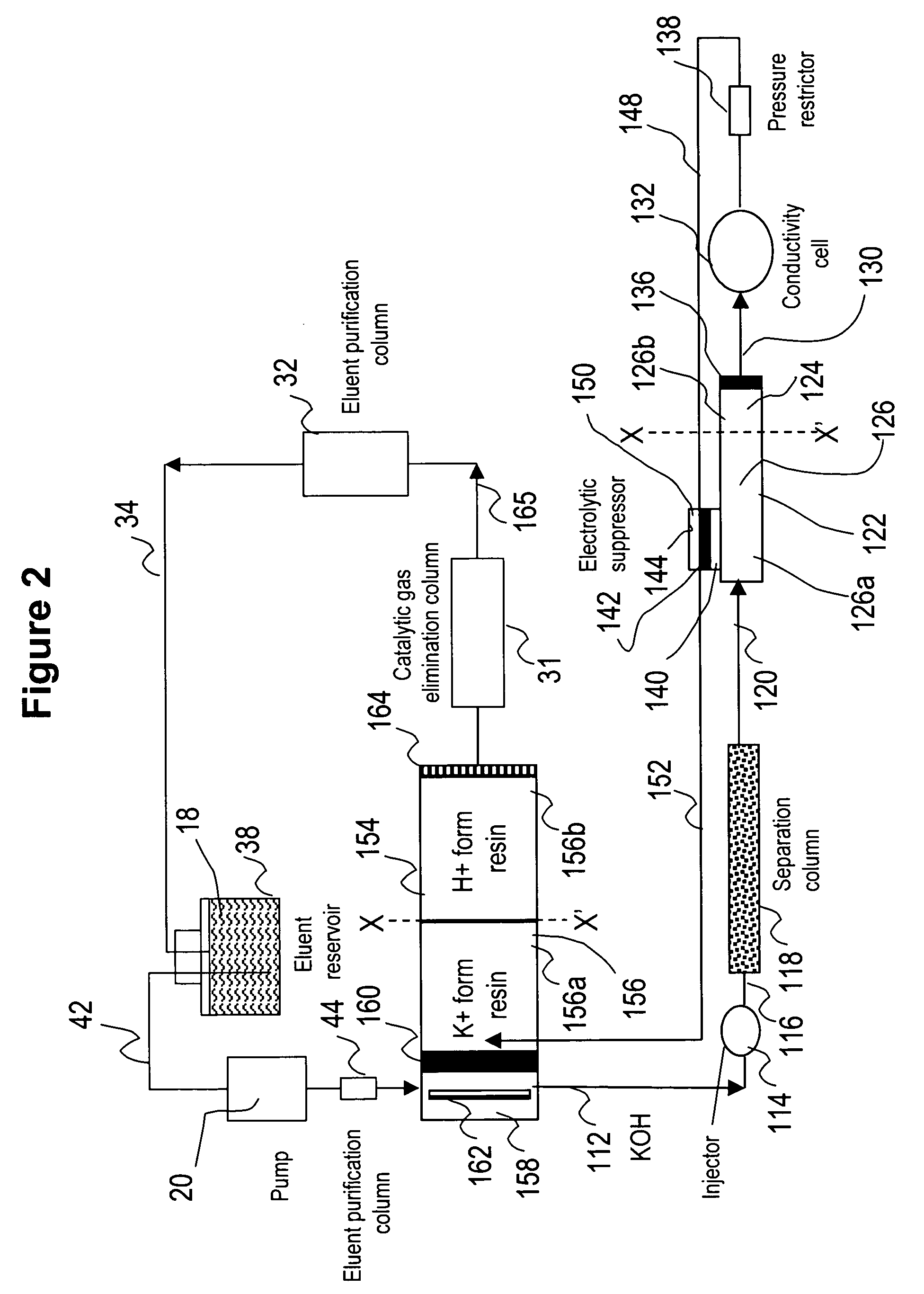Ion chromatography system using catalytic gas elimination
- Summary
- Abstract
- Description
- Claims
- Application Information
AI Technical Summary
Benefits of technology
Problems solved by technology
Method used
Image
Examples
example 1
Ion Chromatographic Separation of Common Anions Using an Electrolytic Suppressor and Recycle of a Sodium Carbonate / Sodium Bicarbonate Eluent
[0083] This example illustrates the use of the eluent-recycle ion chromatography system shown in FIG. 1 for determination of common anions including chloride, nitrate, and sulfate. A Dionex® ICS-1500 ion chromatography system consisting of an isocratic dual-piston high pressure pump, a six-port injector, a column oven, and a conductivity detector was used. A Dionex 4-mm AS4A SC column was used as the separation column, a solution of 3 mM sodium carbonate was used as the eluent, and the separation was performed at 1.5 mL / min. A Dionex anion Atlas® electrolytic suppressor was used in the experiments. The catalytic gas elimination column was prepared by packing small strips of porous Pt foil in a ⅛ OD× 1 / 16 ID×40 cm plastic column. The eluent purification column was packed with ion exchange resins as described previously. In one set of experiments...
example 2
Ion Chromatographic Separation of Common Cations Using an Electrolytic Suppressor and Recycle of a Sulfuric Acid Eluent
[0086] This example illustrates the use of the eluent-recycle ion chromatography system shown in FIG. 1 for determination of common cations including lithium, sodium, ammonium, potassium, magnesium, and calcium. A Dionex DX500 ion chromatography system consisting of a dual-piston high pressure pump, a six-port injector, a column oven, and a conductivity detector was used. A Dionex 4-mm CS12A column was used as the separation column, a solution of 22 mN sulfuric acid was used as the eluent, and the separation was performed at 1.0 mL / min. A Dionex cation Atlas® electrolytic suppressor was used in the experiments. In this example, the catalytic gas elimination column and the eluent purification column were not used. A Dionex TMC-1 trace metal concentrator column was used as the cation trap column placed between the outlet of the conductive cell and inlet of the suppre...
example 3
Ion Chromatographic Separation of Common Cations Using an Electrolytic Suppressor and Recycle of an Eluent Containing Methanesulfonic Acid and 2-Butanone (MEK, Methyl Ethyl Ketone)
[0087] This example also illustrates the use of the eluent-recycle ion chromatography system shown in FIG. 1 for determination of common cations including lithium, sodium, ammonium, potassium, magnesium, and calcium. In this example, a Dionex DX500 ion chromatography system consisting of a dual-piston high pressure pump, a six-port injector, a column oven, and a conductivity detector was used. A Dionex 4-mm CS15 column was used as the separation column, a solution of 12 mM methoanesulfonic acid (MSA) and 5% (v / v) HPLC-grade butanone was used as the eluent, and the separation was performed at 1.0 mL / min. A Dionex cation Atlas® electrolytic suppressor was used in the experiments. No eluent purification or catalytic gas elimination columns were used. A Dionex TMC-1 trace metal concentrator column was used as...
PUM
| Property | Measurement | Unit |
|---|---|---|
| Electrical conductivity | aaaaa | aaaaa |
| Electric charge | aaaaa | aaaaa |
| Content | aaaaa | aaaaa |
Abstract
Description
Claims
Application Information
 Login to View More
Login to View More - R&D
- Intellectual Property
- Life Sciences
- Materials
- Tech Scout
- Unparalleled Data Quality
- Higher Quality Content
- 60% Fewer Hallucinations
Browse by: Latest US Patents, China's latest patents, Technical Efficacy Thesaurus, Application Domain, Technology Topic, Popular Technical Reports.
© 2025 PatSnap. All rights reserved.Legal|Privacy policy|Modern Slavery Act Transparency Statement|Sitemap|About US| Contact US: help@patsnap.com



